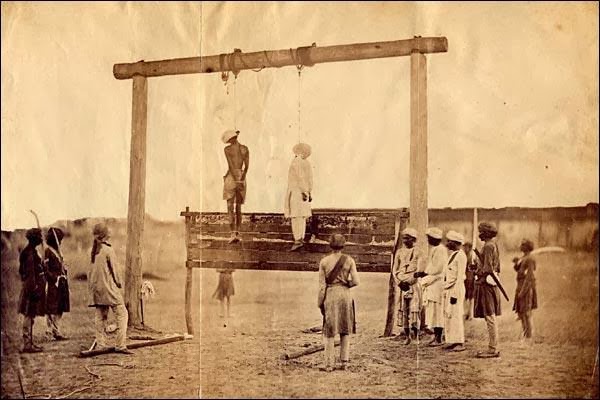
In the year 1857, one of the most important uprisings in world history took place. This is classified as one of the most important because it was against the British and in their biggest and most important colony – India. If successful, it could have emboldened colonised people everywhere and inspired them to revolt against the then burgeoning and colossal British Empire.
As it is, it has gone down in history as one of the most important and spectacular FAILED uprisings.
Tired of the British colonial rule and oppression; the people from various parts of India rose up against the colonialists. The rebellion started when sepoys (soldiers) employed by the British East India Company revolted after continued discrimination, including forcing acts upon them that contradicted their religious beliefs. This was the case for both Muslim and Hindu sepoys. However the rebellion quickly spread to other people, including civilians and some Nawabs (British approved local rulers) who revolted along with their subjects. The spiritual leadership of the revolt was with the final Mughal Emperor – Shah Alam – who was deposed following the revolt by the British, with the Mughal Empire officially disbanded and the last emperor deported to Burma to die in obscurity a few years later.
One of the most important elements of society that it spread to, though, was the Muslim scholars – the ‘Ulema. These numbered in their tens of thousands. Islamic scholarship was strong despite the general decline in learning during the era of the Nawabs that followed the decline of the Mughal rulers. This was because of the strength of traditional Islamic learning in India, particularly the Hanafi Madhab. Most scholars were united by a movement/organisation called Jamiatul ‘Ulema, which consisted of tens if not hundreds of thousands of people (scholars and students of knowledge). These scholars urged the people to rebel, especially the Muslims. In Masjids, sermons were given exhorting people to rise up against the kafir colonialists.
Interestingly, despite their issues, Muslims and Hindus in many cases worked and fought together. In the case of many rebelling Hindu elements they recognised the leadership of Shah Alam as the guide of the revolt. The Mughal authority was by 1857 mainly confined to Delhi and its surroundings, which is where Shah Alam coordinated and advised others from.
While Hindus revolted with the Muslims in many places – and were independent of Muslims in others – for the large part the revolt is seen as a Muslim revolt. It was Muslims who had the greatest motivation in revolting, to regain lost power and prestige, and possessed most of the power until the British East India Company invaded.
The rebellion turned into mini wars and conflicts in various parts of India between the rebels and the forces of the British as well as the many British agents, especially the Nawabs. They used “loyal” employees (i.e. Indian sell outs, both “Muslims” and Hindus) – both the British themselves as well as the Nawabs – to try to quash the various uprisings. In certain places it was confined to protests and demonstrations.
Battles ensued in various parts of India, some going for months, before they were eventually defeated. One after one the centres of rebellion were neutralised by the British and their agents.
What followed was what is known in Arabic and Urdu as qatl ‘aam – general killing. It was bloodshed, massacre and revenge by the British on a massive scale, in which the blood of the rebels and their supporters flowed in rivers. They didn’t do all the killing themselves. Rather, they would use their client Nawabs to do so. The Nawabs would in turn have the relevant people and rebels executed by their subjects, thus meaning that it was Indian forced to kill Indian (as the picture below depicts), and often (sell-out) “Muslim” forced to kill rebel Muslim. The revenge was brutal. People were killed en masse, with the preferred mode of killing being public hanging, in order to teach people a lesson never to try something similar again.
The class of people that suffered the most were the ‘Ulema/scholars and their students and supporters. They were rounded up and made an example of. They were butchered in their tens of thousands, if not more. They were seen as the spiritual inspiration behind much of the rebellion in several centers, and thus “held to account”.
A most common report and articulation of the extent of the massacre is the following: it is said that for the 180 kilometres between Delhi and the city of Moradabad, the road was such that there were trees on either immediate side of the road, forming a canopy and tunnel of sorts for the vast extent of this road. It is said that there was not one tree on this road on both sides of the road except that a corpse of a Muslim scholar/member of Jamiatul Ulema was hanging from it. SubhanAllah – a massacre of gargantuan proportions.
The uprising was defeated, and the revolution that could have been was lost. Muslims were massacred as were other people, but the ones that lost the most were the Scholarly class and through them of course the general people.
For at least a generation or two the Muslims lost almost any willingness to resist, and when the will returned, it did so in other forms and never with the same gusto.
The failed 1857 mutiny is probably the single greatest disaster in the history of the Muslims of Hind. We are still feeling the impacts of this today.
However, it also shows the exemplary courage of the ‘Ulema who stood for the truth and paid with their lives.
May Allah have immense Mercy on them and raise them as martyrs on the last day. Ameen!
May Allah return the glory the Muslims of Hind have lost and forgive them for their shortcomings and mistakes. Ameen.
